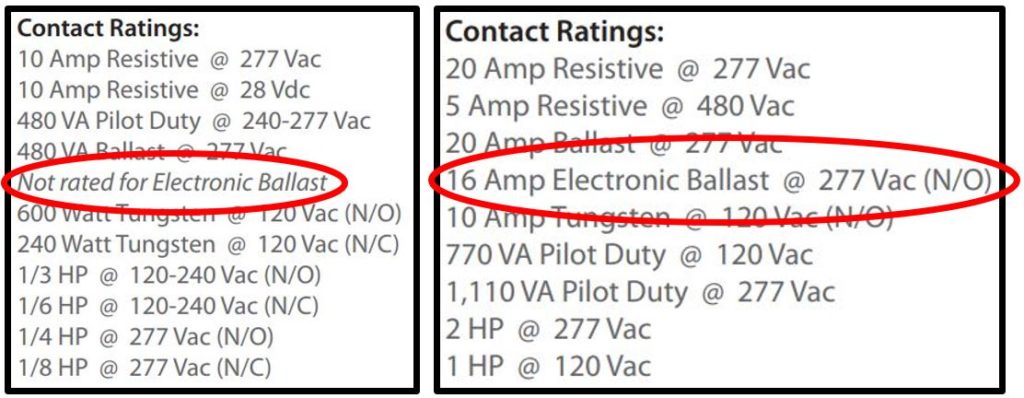Electronic Ballast: What is this contact rating?

Ever glanced down at the relay contact ratings we list and think “What exactly do some of these mean?” That is a very good question! For this week’s Tech Blog post, I would like to focus on the Electronic Ballast rating.
Let’s start by defining what is considered electronic ballast. Are you familiar with those fluorescent lights that sometimes flicker and buzz as they are being used? Odds are that those lights are powered by an older style magnetic ballast. That ballast is usually made up of a core-and-coil type of power source. The updated electronic ballast essentially replaces the core-and-coil components with solid-state electronic components. The electronic ballast makes a more efficient power source for the loads that it powers. This makes it more attractive as the return on investment is shorter.
There is a con to the electronic ballast, unfortunately. The electrical components utilized in the electronic ballast circuitry typically contribute to a large in-rush of current to the load. Basically, for a very short amount of time, the current supplied to the electronic ballast at start can reach many times that which the electronic ballast consumes at a normal rate. That said, the relay contacts that switch on the power that is supplied to the electronic ballast needs to withstand the high in-rush current.
Contact ratings of the RIBU1C relay compared to the RIB2401B relay

Through all the different ratings, we see “Electronic Ballast” clearly addressed on each of the lists. For the RIBU1C relay, we see that the relay device is “Not rated for Electronic Ballast”. The RIB2401B device is rated for “16 Amp Electronic Ballast @ 277 Vac (N/O).” First of all, how was this even determined? Is there someone greater than Functional Devices, Inc. engineers who designated these ratings? To ensure that our relay devices are thoroughly functional for your controls projects, we submit them to UL. Through rigorous and exhaustive testing, RIB products are verified that they will conform to the listed specifications before we begin producing mass quantities.
As a result of the testing, UL has determined that the RIBU1C relay device cannot reliably control any type of electronic ballast load. However, UL has determined that the RIB2401B relay (and any other RIB relay with “B” in the model name after the “RIB” and does not have an override switch) can switch up to 16 Amps worth of an electronic ballast load on the Normally Open relay contact. That rating considers the high in-rush current that electronic ballast loads typically draw. For example, if you have an electronic ballast load that draws 1 Amp of normal running current, then up to 16 of those loads may be controlled by the RIB2401B relay on the Normally Open relay contact.
Electronic Ballast Loads
What are examples of electronic ballast loads? All the new LED drivers on the market fall into the electronic ballast category. That would include the LED bulbs that you can purchase at any home improvement supplies retailer. Many AC to DC power supplies or converters may be considered a type of electronic ballast. The electrical components used in the power supplies or converters are similar to the electronic ballast loads. A lot of different loads fall into the AC to DC converter category. If you have any questions about the type of load you want to control with a relay and which relay to choose, please call us! We’ll be happy to make a relay suggestion.
